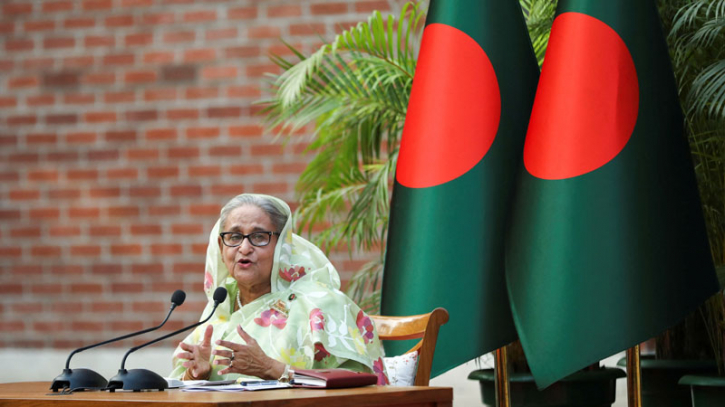Bangladesh govt moves to speed up foreign-funded projects

As Bangladesh urgently seeks foreign exchange, it faces a significant backlog of nearly $48 billion in foreign loans as of December 2023. This amount, which is nearly two and a half times the current foreign exchange reserves, remain largely untapped due to project implementation challenges.
The government has now decided to form a high-level committee to speed up foreign-funded projects to expedite the disbursement of foreign loans from development partners. This will also revitalise the country's dwindling forex reserves.
The committee, headed by the prime minister's principal secretary, will meet once in two months to review the progress of the projects.
Its primary focus will be to pinpoint issues holding up foreign-funded projects and solve them. Where lack of collaboration from development partners is a challenge, the committee will try to find solutions through discussions.
The decision was taken at a meeting of the Bangladesh Planning Commission, chaired by Prime Minister Sheikh Hasina, at the NEC conference room in Sher-e-Bangla Nagar of the capital yesterday.
The last meeting of the Planning Commission took place on 21 January 2015.
Planning Minister Abdus Salam and Satyajit Karmaker, a member (Programming Division) of the Planning Commission, briefed reporters after the meeting.
"We have to complete the ongoing foreign-funded projects quickly," the planning minister quoted the PM as saying.
Satyajit Karmaker said, "We are obligated to repay the loans from the development partners. The prime minister has directed the timely implementation of projects and approved the formation of the high-level committee to ensure that."
According to Planning Commission officials, the failure to implement projects on time resulted in overall cost overruns.
For example, the ADB-funded project for constructing the railway from Dohazari in Chattogram to Cox's Bazar, initiated in 2010 with an estimated cost of Tk1,852 crore and a projected completion time of three and a half years, faced delays. Consequently, an additional expenditure of approximately Tk16,182 crore is now anticipated for the project.
Similarly, the Khulna-Mongla rail line project, funded by India, started in 2010 with a planned conclusion by 2013 and an estimated cost of Tk1,721 crore. However, project delays have led to an increase in the overall cost by Tk2,539 crore.
At the briefing, the planning minister said various reasons delayed project implementation including inaccurate feasibility studies and a shortage of experienced project directors.
According to a report presented during the meeting, the allocation for the health sector has surged by 313.33% or Tk8,366 crores over the past decade. Project durations have extended, leading to escalating project costs. Over the last five years, the average duration of health sector projects has increased by 55.26%, accompanied by a 13.03% rise in project expenditures. On average, three project managers have served per project.
The planning minister said, "Moving forward, the prime minister directed conducting proper feasibility studies before initiating any project. She also pointed out instances where projects had to be halted midway due to improper feasibility studies, resulting in necessary design changes and subsequent delays in implementation, ultimately leading to increased costs."
Insufficient expertise of project directors often causes delays in implementation. To address this issue, a decision has been made to establish a panel comprising experts. The appointment of the project director will be made from among the members of this panel, said the planning minister.
The planning secretary said the reinforcement of the project selection committee to ensure that less crucial projects with low economic returns are excluded from the list of Annual Development Programme (ADP).
Previously, new projects were selected by members of the Planning Commission's Programming Division. However, moving forward, each of the five departments within the commission will have a dedicated member in the selection committee. It will streamline the process of selecting projects, the secretary said.
Why do projects face delays?
According to officials from the Economic Relations Department (ERD) and the Planning Commission, there are a number of reasons for delays in development projects, particularly those funded by foreign sources.
Both implementing agencies and development cooperation agencies contribute to these delays. Issues such as inadequate feasibility studies, complications in land acquisition, delays in utility shifting, frequent changes in project director, delays in the tender process, and delays in the revised project proposal process have been highlighted in reports from the Planning Commission and ERD on different occasions.
Additionally, development partners impose specific conditions on their projects throughout the implementation process. Permissions needed at various stages are time-consuming. Occasionally, local offices of development partners cannot make quick decisions as they need to get approvals from their headquarters.
Moreover, where development cooperation organisations, such as the Asian Infrastructure Investment Bank (AIIB), do not have offices in Bangladesh, the permission takes time.
According to a report from the ERD in November last year, the absence of a regional office of the AIIB contributes to the delay in releasing project funds.
Project officials said that delay in paying contractors has also made them less enthusiastic.
The AIIB is providing $2.07 billion for 13 projects, where implementation progress has been slow. Until September last year, only 22% or $458.45 million had been disbursed.
Notably, the approved implementation period for most of these projects has expired, with the remaining ones reaching the final stages.
This list includes projects such as upgrading the Sylhet-Tamabil Road to a 4-lane highway and the construction of the Kewarkhali Bridge in Mymensingh.
Slow implementation behind low disbursement
ERD officials said foreign aid allocation in the revised Annual Development Programme (ADP) is decreasing every fiscal year due to challenges in expenditure.
In the current fiscal year, a cut of Tk20,500 crore from the foreign allocation of the revised ADP has been proposed (down from Tk94,000 crore to Tk73,500 crore).
Furthermore, after each fiscal year, a portion of the revised ADP remains unutilised. For instance, approximately 10% of the revised allocation went unspent in the last fiscal year.
ERD officials said a considerable amount of foreign financing is held up in the pipeline due to the non-utilisation of foreign funds, amounting to $47.63 billion as of last December.
8FYP could be hindered due to a disparity in allocation
The 8th Five Year Plan, a projected course of action for the July 2020-June 2025 period, has allocation targets for the ADP to achieve a set of development goals. However, allocations to various sectors in ADP are not aligning with the projections outlined in the five-year plan.
After the planning commission meeting, the planning minister said that steps have been taken to address this allocation disparity in the meeting.
As per a report presented during the meeting, a scrutiny of the ADP allocation for FY24 reveals discrepancies compared to the projections outlined in the five-year plan.
For instance, the health sector, which was initially projected to receive an allocation of 11.1%, has been allocated 6.16%.
Similarly, the agriculture sector, projected to receive 11.5%, has been allocated only 4.07%. The rural development sector, expected to receive 12.1%, has been allocated 7.18%.
Conversely, the power and energy sector, as well as the transport and communication sector, are receiving allocations surpassing the initial projections.
The real allocation to the power and energy sector stands at 16.88%, surpassing the projected figure of 14.8%. Similarly, the transport and communication sector received an allocation of 28.88%, exceeding the initial projection of 17.4%. In the Housing and Community Facilities sector, the ADP allocation is 10.28%, well above the projected figure of 2.3%.
The inconsistency in funding raises uncertainties regarding the attainment of the targets outlined in the five-year plan.
Source: The Business Standard.
.png)




